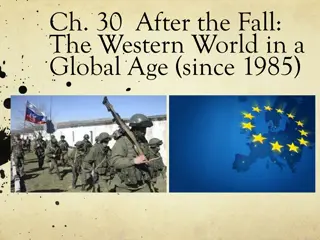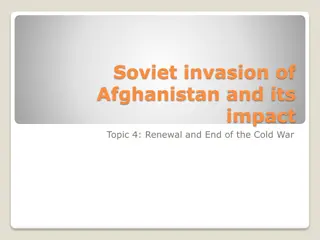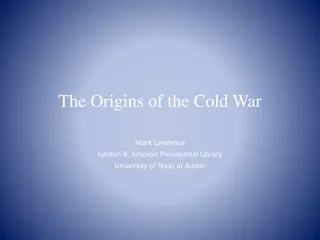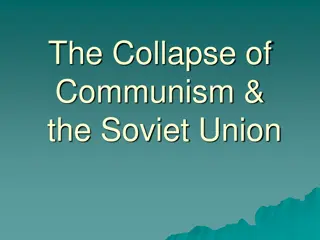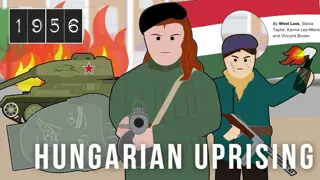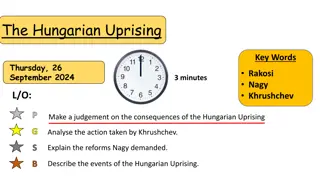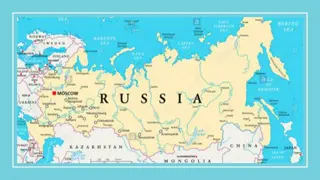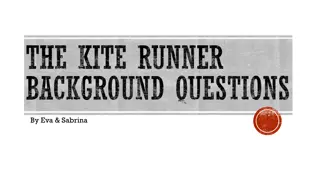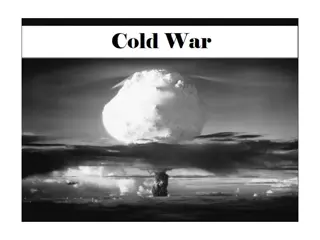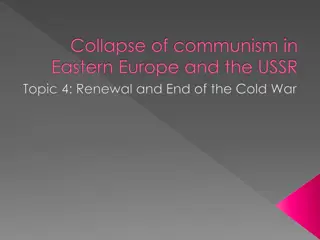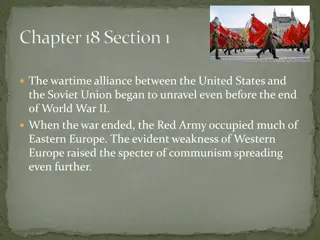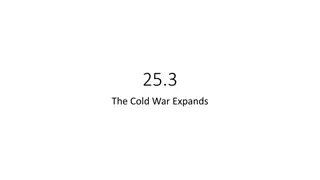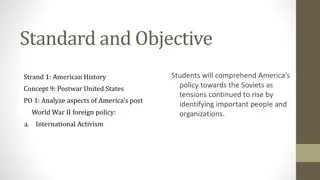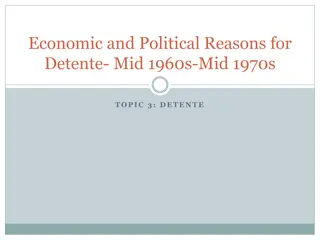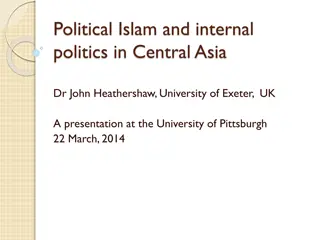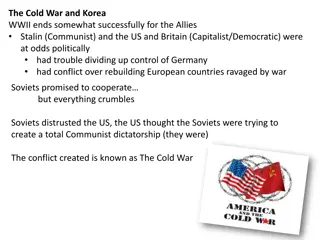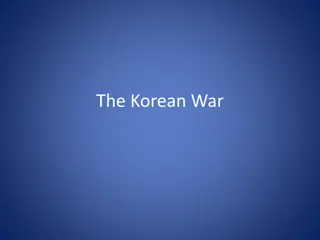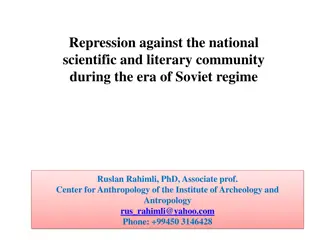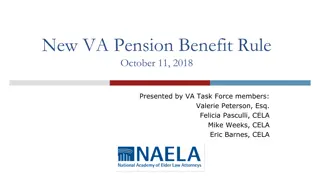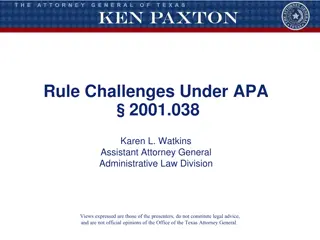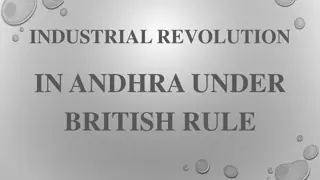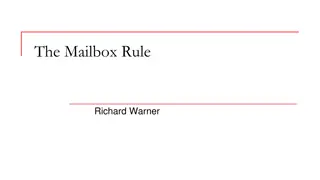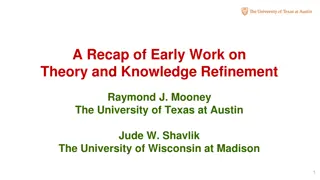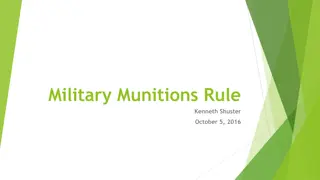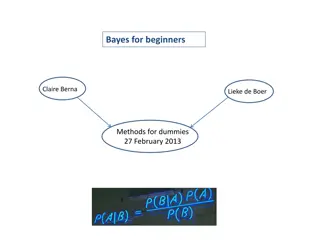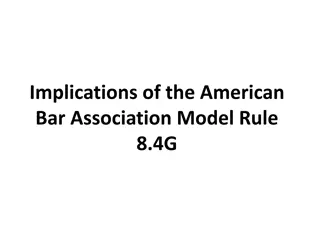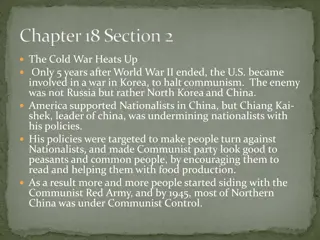Transformation of Soviet Society Under Stalin's Rule
Stalin's impact on Soviet society and culture was significant, with a mix of promoting change and continuity. This essay evaluates the extent of transformation in areas such as standard of living, attitudes, arts, ethnicity, gender roles, and family life. While Stalin's conservative policies reinstated traditional values in some aspects, other areas like working life experienced transformation. The analysis delves into the nuanced effects on education, art, music, literature, and cultural diversity under Stalin's regime.
Download Presentation

Please find below an Image/Link to download the presentation.
The content on the website is provided AS IS for your information and personal use only. It may not be sold, licensed, or shared on other websites without obtaining consent from the author. Download presentation by click this link. If you encounter any issues during the download, it is possible that the publisher has removed the file from their server.
E N D
Presentation Transcript
RUSSIA & RUSSIA & THE SOVIET UNION THE SOVIET UNION 1917 1917- -1941 1941
If you meet with difficulties in your work, or suddenly doubt your abilities, think of him of Stalin and you will find the confidence you need. If you feel tired in an hour when you should not, think of him of Stalin and your work will go well. If you are seeking a correct decision think of him of Stalin and you will find that decision. Pravda, 1950 Pravda, 1950
Evaluate the extent to which Stalin transformed the social and cultural life of the Soviet Union In order to give sharp focus to your answer, a clear understanding is needed of what society is (refers to a group of people with common government i.e. Soviet citizens and their culture i.e. their values, attitudes, beliefs) Provide a clear and logical thesis in the introduction. The word transformed = produced a new type (of society and culture) Therefore, it is important to say something about Russian society and culture before Stalin Work out a valid set of criteria by which to make an accurate evaluation What were the various elements of soviet society and did Stalin promote change or continuity in each of these? The question is asking more than just How did Stalin effect people s lives . This may be a part of the answer, but the concepts of society and culture are more specific
Evaluate the extent to which Stalin transformed the social and cultural life of the Soviet Union ASSESSMENT CRITERIA 1. Change or continuity to the standard of living? 2. Change or continuity in attitudes and beliefs? 3. Change or continuity to arts, music, literature? 4. Change or continuity to ethnic groups? 5. Change of continuity in gender roles and family?
Evaluate the extent to which Stalin transformed the social and cultural life of the Soviet Union INTRODUCTION: INTRODUCTION: Stalin s conservative policies saw a return to traditional values in many areas of Russian social and cultural life. He reacted against the radical transformation of Russian society and culture that resulted from the October Revolution, effectively undoing many social reforms of the 1920 s. However, other aspects such as working life were transformed under Stalin. This essay will examine the extent to which Stalin promoted either change or continuity in the working life, family life and gender roles of ordinary Soviet citizens. Stalin s impact on soviet education, art, music, literature and cultural diversity will also be examined.
Evaluate the extent to which Stalin transformed the social and cultural life of the Soviet Union 1. 1.Living standards Living standards Deteriorating working conditions - unrealistic production targets Predominance of work ethos over all other aspects of life (e.g. the Stakhanovites ). Urban population growth - overcrowding, crime and poverty Scarcity of consumer goods for ordinary citizens Denunciation in the family and workplace led to a culture of fear and paranoia Emergence of a new ruling class with special privileges 2. 2.Shaping Attitudes and beliefs Shaping Attitudes and beliefs Aim of Stalinist propaganda - the citizens first loyalty should be to the state Suppression of religion (e.g. League of Militant Atheists ). Education - Education Act of 1935 emphasised technical education and ideology (e.g.' Short course ). The progressive reforms introduced after the revolution were removed
Evaluate the extent to which Stalin transformed the social and cultural life of the Soviet Union 3. 3. Russian culture Russian culture In the 1920 s the Soviet Union had seen an explosion of creativity Stalin dismissed most art as bourgeois and esoteric it served no practical purpose Under Stalin all art had to conform to the concept of Socialist realism - work had to be easily recognised and remembered by the ordinary citizen. Stories of heroic deeds were used to motivate workers to help build socialism Purges against artists, writers, composers who didn t conform limited the freedom of expression 4. 4. Ethnic groups/nationalities Ethnic groups/nationalities Under Stalin, Soviet patriotism sought to eliminate cultural differences The Ukrainian famine of 1932-33 demonstrated of Stalin s attitude to the nationalities Suppression of Judaism, Buddhism and Islam in ethnic regions of the USSR In the Ukraine, senior officials were replaced with ethnic Russians Ethnic Russians dominated local committees Non-Russian recruits in the Red Army were sent a long way from their home
Evaluate the extent to which Stalin transformed the social and cultural life of the Soviet Union 5. 5. Gender roles/family Gender roles/family The liberal reforms of the Bolsheviks led to social problems: 37% divorce rate in Moscow abortions outstripped live births by nearly 3 times many orphans were created due to mass deportation To make ends meet many women were forced to go to work Crime and poverty were widespread Stalin introduced an era of social conservatism in the USSR that became known as the great retreat Out went: abortion homosexuality modern immoral dress de-feminised images of women as socialist heroes In came: the restoration of inheritance (to strengthen the family unit) the restoration of wedding ceremonies and the sale of gold rings tighter divorce laws propaganda promoting family values and abstinence Single-sex education
Under Under Yagoda Yagoda 1934 1934 - - 1936 1936 Led the change from the OGPU to the NKVD Responsible for enforcing the verdicts of the show trials Began the purging process that would proceed the Great Terror
Under Under Yezhov Yezhov 1936 1936 - - 1938 1938 Responsible for the majority of the Purges Directly responsible for the Polish Operation , where 110,000 Poles were systematically eradicated Tripled the population of the gulags First to openly admit that the NKVD had targeted innocents: There will be some innocent victims in this fight against Fascist agents. We are launching a major attack on the Enemy; let there be no resentment if we bump someone with an elbow. Better that ten innocent people should suffer than one spy get away. When you chop wood, chips fly
Under Beria 1938 Under Beria 1938 - - 1945 1945 Turned the NKVD into a well-oiled killing machine Ramped up production on murder vans, and revolutionized mass graves in the USSR Finished the purging of the Red Army Stalin introduces Beria as our Himmler NKVD leadership, under Beria, suspected of killing Stalin NKVD carries out massive purging of doctors and nurses as part of the Doctors Plot
This Russian cartoon was produced during the civil war. What does it suggest about the attitude of the Bolsheviks towards foreign powers (the dogs represent the White generals)?
Competing interests in Soviet Foreign Policy Competing interests in Soviet Foreign Policy Should the Bolsheviks actively support revolutionary movements in Europe and so risk war with other nations ( Revolutionary foreign policy)? Or should it build upon the revolution by encouraging foreign investment ( Traditional foreign policy)? Two organisations - Comintern and the Commissariat of Foreign Affairs embodied these different attitudes to Soviet foreign policy These differences were later expressed by Trotsky ( Permanent Revolution ) and Stalin ( Socialism in One Country ) The civil war showed that foreign powers saw the Bolsheviks as a threat to their own stability. The creation of Comintern in 1919 seemed to confirm these suspicions If Soviet Union was to survive in a hostile capitalist world it had to keep pace with Western technological advancements Most of the investment for this had to come from the rich capitalist powers
Foreign Policy Pragmatism Foreign Policy Pragmatism The failure of the Bolsheviks in the Russo Polish War Polish War (1920) showed there was little hope of exporting the revolution to neighbouring countries Russo- - With the withdrawal of foreign troops after the civil war, Lenin believed the Bolsheviks had achieved a breathing space Realising that Western investment was needed for Russia to modernise, co-operation with capitalist powers was advocated and a policy of peaceful co peaceful co- -existence existence pursued
Foreign Policy Pragmatism Foreign Policy Pragmatism Lenin s appointment of Georgy Commissar of Foreign Affairs reflected a new pragmatism in Russian foreign policy that tried to maintain normal diplomatic relations with major capitalist governments Georgy Chicherin Chicherin as As a former Tsarist foreign official who had been a Menshevik, Chichern s skills in foreign diplomacy were seen as essential by the Bolsheviks Chicherin believed that Britain posed the greatest threat to the Soviet Union and therefore sought to forge friendships and alliances wherever he could The Treaty of Rapallo Treaty of Rapallo (1922) and the Treaty of Berlin Berlin (1926) saw the two pariah states of Germany and Russia unite. The Soviets were provided with industrial equipment and technology Treaty of
Foreign Policy developments in the 1920s Foreign Policy developments in the 1920 s Despite the efforts of Soviet diplomats to achieve harmonious relations with the west, hostility was always close to the surface The Zinoviev Letter Zinoviev Letter is credited to have brought down the British Labour government in the 1924 General Election Supposedly written by Grigori Zinoviev Grigori Zinoviev, president of Comintern to the Communist Party of Britain, the letter advocated intensified Communist agitation in Britain, not least in the armed forces (it was later discredited as a forgery) Soviet encouragement for a general strike in Britain in 1926 undermined the efforts of the Commissariat of Foreign Affairs to establish political and economic relations at an official level Grigori Zinoviev 1883-1936
Foreign Policy developments in the 1920s Foreign Policy developments in the 1920 s In 1927, Britain broke off relations with the Soviet Union, causing a brief war scare. This enabled Stalin to remove left-wing critics such as Trotsky who argued for a revolutionary foreign policy With the onset of the Great Depression 1929, Western nations were eager to sell their resources to the Soviet Union which was beginning its rapid industrialisation However, many Communists interpreted the onset of the Great Depression as the fulfilment of Marx s prediction that capitalism would eventually destroy itself. Great Depression in Grigori Zinoviev 1883-1936
Collective Security (early 1930s) Collective Security (early 1930 s) As capitalist nations recovered from the Great Depression all hope of a world revolution virtually disappeared. Prior to the Nazi takeover of Germany in 1932, the Soviet Union had come to rely heavily on German equipment and engineers in its pursuit of rapid industrial growth With the Nazi takeover in Germany, a new threat to the Soviet Union appeared. Hitler was avowedly anti-communist and via his SA, sought to actively destroy the German Communist Party In line with his policy of Socialism in One Country , Stalin stood aside while Communists in other countries (such as Germany and China) were attacked Japan s conquest of Manchuria in 1931-32 also persuaded Stalin to seek closer defensive alliances: 1932: A defensive Pact was signed with France 1932: USA gave the Soviet Union diplomatic recognition 1932: Soviet Union joins the League of Nations Comintern was forced to abandon its revolutionary direction in favour of broad alliances with a range of left-wing groups in popular fronts . After 1935 it held no more conferences. Stalin formally abolished it in 1943
Isolationism after 1936 Isolationism after 1936 The formation of an Anti-Comintern Pact between Germany, Japan and Italy in 1936 saw the Soviet Union even more isolated than before Stalin's purge of the Red Army from 1936-38 removed: More than half the officers 90% of all generals 80% of all colonels Almost the entire Soviet General Staff, who were tried and executed as German spies Laver refers to this as the decapitation of the Red Army . This left the Soviet Union vulnerable to invasion from Nazi Germany As a result of these purges, Britain and France were reluctant to rely on the Soviet Union to help them meet the emerging threat of Nazism The upheaval of collectivisation and the first Five-Year plan also severely weakened the Soviet Union militarily: The army was used to force collectivisation onto the peasantry. This led to bitter conflicts between the two The peasantry was the main source of recruits for the army. Therefore enlistment declined Millions of horses had been slaughtered at a time when the army made great use of horses for the cavalry and for transport
The Nazi The Nazi- -Soviet Pact (1939) Soviet Pact (1939) Germany and Russia agreed to bury the hatchet; they agreed to bury it in Poland BBC TV, BBC TV, Why Appeasement Why Appeasement? ?
The Nazi The Nazi- -Soviet Non Soviet Non- -Aggression Pact (1939) Aggression Pact (1939) By the 1936 it was apparent that the Soviet Union was in no position to fight a war To avoid war the Soviet Union had to end its isolation from the rest of Europe. Two alternatives were available: 1.Join an anti-Fascist alliance with France and Britain (as had occurred in 1932) OR 2.Make an alliance with the Fascists Hitler aims of expansion were given further encouragement by the Munich Agreement (signed in September 1938 between Hitler and the democratic nations) Stalin interpreted the exclusion of the Soviets from this agreement as a sign that Britain and France sought to turn Germany against the Soviet Union After failing to receive support from Britain and France, Stalin considered a non- aggression pact with the Nazis. For Hitler the appeal of such a pact was that he could avoid a war on two fronts, which had bedevilled Germany since its unification The Nazi-Soviet Non-Aggression Pact was signed on 2 August, 1939 after secret negotiations In return for Soviet neutrality Germany promised to: return land taken in 1917 that later formed parts of Poland Allow the Soviets to expand into Finland and the Baltic states Provide access to German industrial and military equipment
The Soviet Union at War The Soviet Union at War The Winter War (1939 The Winter War (1939- -40) As a result of the Five-Year plans, the Soviet Union had caught up industrially to the powers of Western Europe. Militarily it could now compete. Finland was its first target (Hitler had guaranteed not to intervene should the Soviet Union seek to expand there) Despite Soviet victory, the Finns successfully managed to repel Soviet advances. However, eventually they succumbed The results of the Winter War were: The Soviet Union lost 200,000 men; 700 planes; 1600 tanks (the Finns lost 25,000 men) The Soviet Union was expelled from the League of Nations Hitler gained renewed confidence that a weakened Soviet Army could be easily overwhelmed once he had successfully concluded his war in Western Europe 40) The outbreak of the Great Patriotic War (1941) The outbreak of the Great Patriotic War (1941) Stalin s decision to occupy parts of Eastern Europe after the Winter War soured relations with Germany, as these territories were not discussed in the Non-Aggression Pact September 1940: Tripartite Pact signed between Germany, Italy and Japan April 1941: Neutrality Pact signed between the Soviet Union and Japan June 1941: Operation Barbarossa sees German forces invade the Soviet Union
The Soviet Union at War The Soviet Union at War The Allies The Allies Britain wanted to survive as a great power, with its empire intact. Despite his hostility before the war, Churchill did want to remain on good terms with the USSR after the war ended, but he was worried about Stalin using the war to expand Soviet territory. As Britain had gone to war to protect Poland in 1939, they also wanted at least some democratic government in that country. The Soviet Union also wanted to continue cooperation with the United States and Britain after the war. Stalin even abolished the Comintern as a sign of his good faith. However he was determined the USSR would have security from future attacks and wanted an area under Soviet control and also foresaw an intermediate zone of neutral countries between Soviet territory and Western Europe The United States The United States Early historians suggested that the United States had no clear idea of its goal for the post-war world, especially in Europe. The United States did promote its own agenda after joining the war, objecting to British plans when they felt Churchill was trying to use them to prop up the British Empire. President Roosevelt handled his relationship with Stalin with care, and often allowed Stalin to get most of what he wanted
The Soviet Union at War The Soviet Union at War The Tehran Conference 28 November The Tehran Conference 28 November 1 December 1943 The US and Britain would invade Europe from the west, taking pressure off of the USSR in the East. Churchill had wanted an invasion through the Balkans, to stop the Soviet Union taking too much territory for himself. Roosevelt managed to persuade him not to oppose Stalin this way. 1 December 1943 The Soviet Union would join the war against Japan once Germany had been defeated The USSR would be allowed to re-annex parts of Poland, but Poland would be compensated with land from Germany Poland Poland When the Red Army invaded Poland, they destroyed the Nazi occupation, but this was not Stalin s only aim. The Polish government in London was supported in the country by a nationalist resistance movement the Polish Home Army. Stalin was determined not to allow this group to take power, and the Polish government was highly suspicious of the Soviet liberation. The Home Army took control of Warsaw in order to prevent the Red Army taking control of the capital. However they were defeated by the Germans, and the Soviet Army, although only 20 miles away, did nothing to help them.
The Soviet Union at War The Soviet Union at War Yalta February 1945 Yalta February 1945 Germany would be occupied by the three allies and France. The country and the capital, Berlin, would be divided into occupation zones. The Nazi Party would be banned, and war criminals tried in an international court. The United Nations would be set up, and all three allies would be permanent members of the security council. At War s End At War s End Europe was liberated from Nazi occupation The Nazi Party itself was destroyed The USSR reclaimed the land it had lost in the Nazi invasion Britain had, for the moment, survived as a major power The United States had restored a stable environment to trade in.


